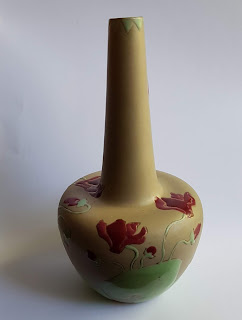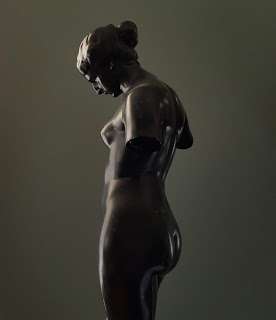I have had this beautiful pretty little vase for over a decade.Many
have tried to prise it away from me but up to now I have not given in
to the lure of....money. I keep thinking where am I going to find
another one.

It is decorated so simply with floral decoration applied in enamel
over a earthenware base. It looks like the flowers are swaying in the
wind.
Its only 17cm high, and as a potter I can tell that the thrower has
just patted the rim down creating a ever so delicately placed dimple
around the neck of the piece where it becomes more rotund, that just
gives it a little something extra.

Now even after all this time and without too much research I have to
admit I don't know who the exact decorator is. I would love to think
its a Ernest Bussiere piece but it could be Louis Majorelle or
Lachenal. What I do know is its a little gem.
Signed K G Luneville that is the mark for Keller and Guerin.

In 1728 Jacques Chambrette established the first earthenware factory
in Lorraine, in Lunéville besides the river Meuse, not far from
Vezouse.
He
formulated a new type of earthenware called "terre de Lorraine"
in 1748 based on the study of English potteries.
He had great economic and artistic success.

The factory was awarded the status of Manufacture Royale de Fayence
by the Ducs of Lorraine in 1749.
The Lunéville manufacture was ti rival the expanding English and
German ceramics centres and Chambrette managed to successfully export
his wares to Italy, Germany, Poland, Switzerland and even The
Netherlands.
In
1786 Sébastien Keller bought Luneville from the Chambrette family
following the bankruptcy of the pottery manufacturer in 1785. For the
next 137 years, the Keller family controlled the company. In 1832,
Sébastien Keller's son aligned with his brother-in-law Guérin to
give birth to the mark K&G (or KG) from the names Keller and
Guérin and during the following
century, Lunéville was the seat of "Keller and Guérin"
(Société KG).
Between 1700 and 1800 several faience manufacturers installed their
companies in a tight network in Lorraine. The factories produced
everyday utilitarian and decorative objects.
Since silver dinner services were prohibited by the king (who used
the taxing of such objects to finance his wars), faience
manufacturers were able to sell wares more easily.
The artisans were inspired by their surroundings; Subjects were
decorated with naturalistic styles, faience was decorated with
flowers, insects, real and fictitious animals and exotic figures.
They produced faience dogs, which were placed in the halls of houses
( the French have an expression "to stare at each other like
faience dogs").
Later on Chinese decorations, introduced by
Jesuits who brought back examples from their often dangerous
missions. Jacques Chambrette, who suffered from the high taxes that
were imposed on him in the ducal region that was controlled on behalf
of the King of France, coveted the episcopal area, which was
connected to France, but where the influences of Louis XIV were much
less smothering.
In 1758, Jacques Chambrette started a second faience factory in
Saint-Clément, which lies in the Diocese of the Bishop of Metz. In
the 19th century the originally German family Keller, soon allied
with Guérin. This gave new life to the factory by industrialising
it.

This was an era in which Lunéville and its surroundings provided
very skillful workers.
The area around the faience factory, under patronage of Sainte Anne,
developed.
In
1900, there were around 1,100 employees. The factory's products had a
worldwide reputation and participated successfully in various fields
of art and industrial exhibitions.
During the design period we know as Art Nouveau Keller and Guirin
employed some of the most gifted designers Louis Majorelle and Ernest
Bussiere were to create some of the finest designs. Lachenal would
add to the design base of the company.
In 1922 Édouard Fenal,
originally from Pexonne and Badonviller, bought the factories of
Lunéville and Saint-Clément, so employment was guaranteed in
Lunéville and Saint-Clément.

New designers were brought in to cater for the new wealth that was
around and the new style that we now know as art deco rushed in with
its geometric lines.
Mougin Brothers would help to bring the whole area into a new style.
The Second World War marked a recession.
The name Geo Conde is often seen on wares.
St Clement produced huge quantities of crackle glazed animaliar
following the French tradition of sculpting the animal form that went
back centuries.
The production of these in ceramic made them more affordable. Some of
these animals were of varying quality some having slightly strange
colour combinations of deep reds and blues that are highly
collectible today.

In 1979 a new group was further developed by buying out the
Sarreguemines ceramics complex. Édouard's son, Gilbert, was in
charge of the group which also comprises Salins, Vitry-le-François
and Digoin.
The Lunéville production stops in 1981.
Only the factory of Saint-Clément is still operational by1999.
In the renovated buildings nowadays small and medium sized
companies are still working.
 Its that time of the year again. January, its the customary time to pay your tax as many of you self
employed antique dealers out there may realise
Its that time of the year again. January, its the customary time to pay your tax as many of you self
employed antique dealers out there may realise  This sculpture modelled in Contaposto
pose is as good as it gets. Combined with it being a Venus. It ticks
a lot of boxes in a lot of peoples list of wants. As it has mine for
so long. She is 54cm high and has the most amazing patina. Please
don't buy it.
This sculpture modelled in Contaposto
pose is as good as it gets. Combined with it being a Venus. It ticks
a lot of boxes in a lot of peoples list of wants. As it has mine for
so long. She is 54cm high and has the most amazing patina. Please
don't buy it.





